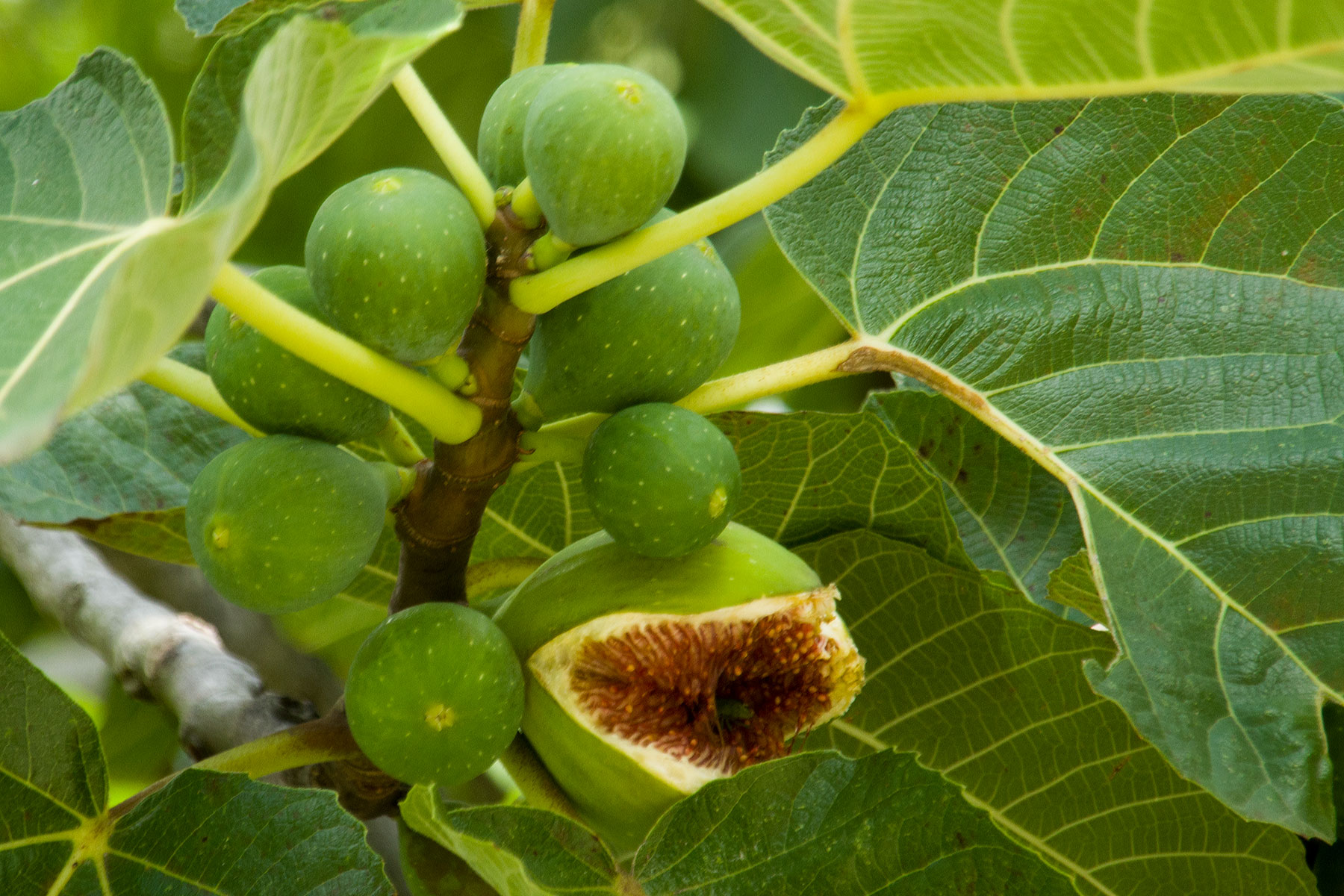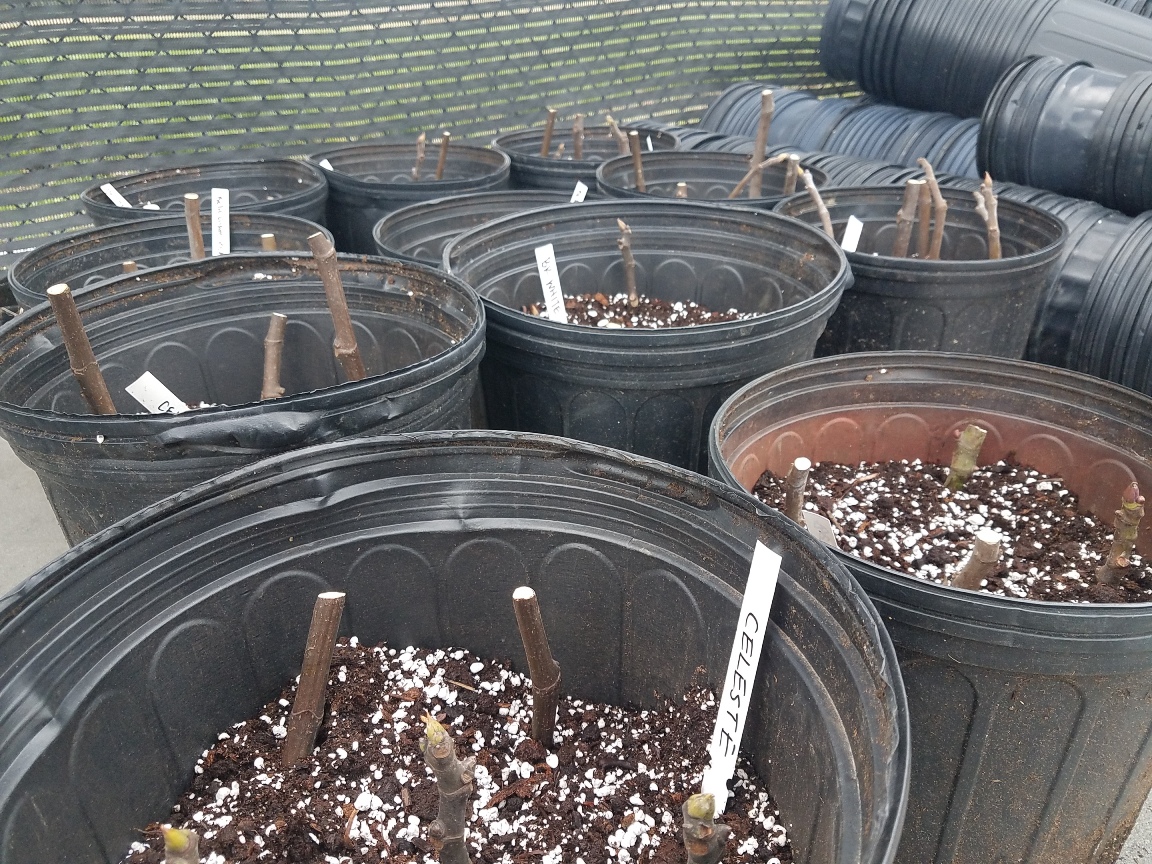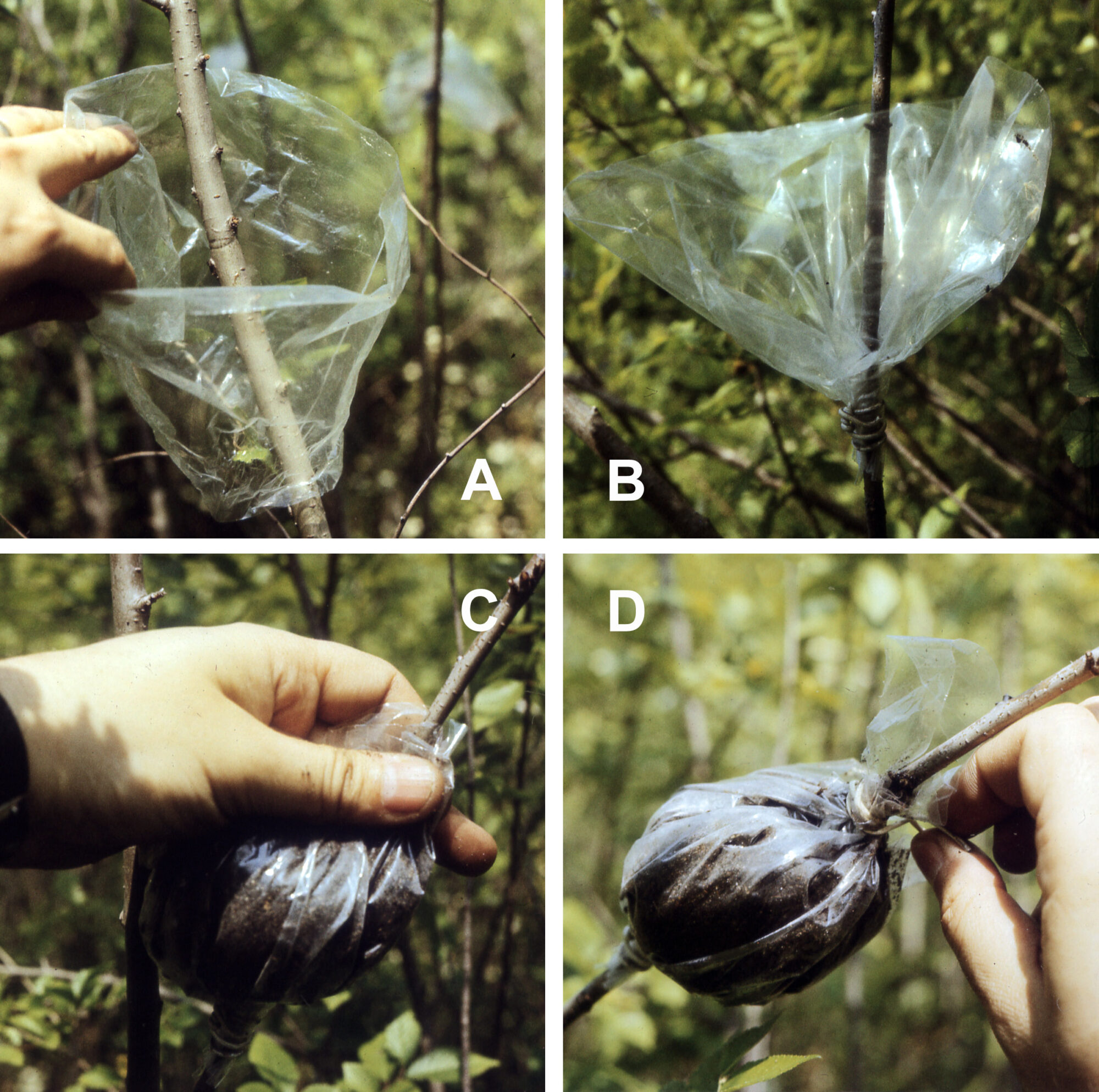It seems too good to be true that figs– a plant that is indigenous to a Mediterranean climate– actually thrives in our climate. Despite figs preferring milder winters and dry summers, certain fig varieties seem to do just fine in this region with a little extra help. POP makes sure to only plant the cold hardy varieties. The abundance of the fruit is also a miracle! Fig trees will produce well for many decades. Anyways, there is every reason to want to plant a fig tree, but buying a seedling is not always a financial option for folks and growing from seed is no easy task. Vegetative fig propagation is not only easy and free, but also a fun, educational, and inspiring journey.

Source: Wikimedia Commons
FIG PROPAGATION BASICS
Vegetative (meaning not from seed) fig propagation is an economical way to grow your own figs and to cultivate specific varieties. The main methods are: stem cuttings, ground layering, air layer, and rooting in water. If taking cuttings or rooting in water, it is important to take cuttings in the dormant season. It’s best to do ground layering and air layering in warmer temperatures to allow for root growth, during spring or summer. Planting the newly propagated fig into the ground is best done in early spring. Below are the four methods that have their pros and cons depending on your situation.
HOW TO PROPAGATE
Stem Cuttings
The most popular method of rooting figs is through dormant cuttings. It’s best to take the cuttings in the winter, either before or after the danger of frost. POP generally takes the cuttings in late fall after leaves have dropped and the trees have gone dormant. These cuttings are stored in the fridge, wrapped in slightly damp newspaper inside a plastic bag to retain moisture. It is also possible to take cuttings at the end of a mild winter or from trees that have been well protected from cold; unprotected branch tips will often die back after a harsh winter, leaving them unviable for propagation.
Using sharp pruners or loppers, take fig cuttings from branch tips from last year’s growth. They should be about ½ to ¾ inches thick and at 1 foot long or more. Longer growth can be cut into smaller segments with at least 4 leaf nodes (where new shoots grow). It’s really not necessary with figs, but the cut can be treated with rooting hormone for a faster rooting. In late March or early April, stick the cut ends into moistened potting soil or perlite/vermiculite in a pot and water deeply. Only one node needs to be above the surface of the pot. Keep the potting soil moist and the pot in the shade until rooting is complete. It usually takes a couple weeks for rooting to start and leaves to begin to emerge. It will take a couple of months to get a good mass of roots. Multiple cuttings can be placed into a single gallon pot; they will be separated later on. After cuttings have succesfully rooted and leafed out, move the pot into a sunny location but away from the direct wind. At this stage, only water if the soil becomes very dry, usually once or twice a week at most. Once the cuttings become fully vegetated, they can separated and placed into bigger pots. They can be planted in the summer or fall, but are very vulnerable to cold at this early stage, so need to be well protected for winter. POP typically keeps the young figs in pots, stored in a shade house or unheated garage or basement, for the first winter and plants them in ground or in larger pots the following spring.

Source: POP
Ground Layering
This method works best in locations where dormant season temperatures never falling below fig-damaging temperatures of 17 degrees. It’s best to do this in the spring or summer. Ground layering is done by burying a portion of a low growing branch (with no figs on it) with 6 to 8 inches of the tip above the ground. Make sure to remove most of the leaves on the branch. The branch can be secured with a stake tied to it or a landscape fabric pin. When the buried portion roots, likely a few months later, the branch can then be severed from the parent tree. While this is the simplest method of fig propagation, it requires warmer temperatures or digging up and potting the young figs to store in a safe place for winter.
Air Layering
Air layering allows you to grow roots directly out of a branch high above the ground. Make sure to do this mid-summer because when you transplant it into a pot it will have enough time to establish itself before cold temperatures. Starting too late in the season will lower your chances of success. A plastic water bottle or plastic bag is a good vessel for this method. Cut the top off of the water bottle, slit the side of the bottle from top to bottom, and cut the bottom off to the right size so that it wraps snugly around branch. Also add some small drainage holes on the bottom using a nail. Make two cuts all around the branch (perpendicular to the direction of the branch) with each cut about one inch apart. Remove the bark between the cuts. Girdling helps to initiate rooting at the desired location because it interrupts the flow of nutrients from the leaves to the roots. Wrap the bottle around the girdled section. Tape the bottle together at the vertical slit so it stays together. Fill with rooting media (either peat moss, coco coir, or a combination). Water it every few days. After it is rooted, cut off branch below the water bottle. Carefully remove bottle because roots are fragile. Pot it up and place in indirect light and high humidity for a couple weeks until it roots out even more. It can then be moved in sunnier location and/or planted in ground in spring/summer. Again, in our colder climate, overwinter the young figs indoors or provide strong winter protection.

Source: Wikimedia Commons
Rooting in Water
There are benefits to rooting fig cuttings in water. Even though rooting cuttings in soil allows the roots to grow naturally and also prevents waterlogged roots, rooting in water keeps the roots moist, allows for the ability to monitor root growth, and has a high survival rate when planted in the ground. To prevent waterlogged roots, change out the water every week. The ability to see the roots is especially helpful, since cuttings will often start growing leaves before they’ve rooted, so it can assist with proper timing for transplanting. Roots will start growing within three weeks, typically, but sometimes longer. The best time to take and root fig cuttings is when you prune your fig tree, which is ideally in late winter or early spring. Early summer cuttings can also work, but it is important to remove most of the leaves from the cutting. Similar to stem cuttings, choose a branch that is 1/2 to 3/4 inches thick with at least three nodes. Cut the bottom at a slant. Remove the leaves and any bugs on the cutting. Give it a quick rinse under lukewarm water. Place in water with at least two nodes under water and change water every week. Indirect light is more than sufficient and keep away from freezing temperatures. It’s ready to plant in pot or ground when it has a few healthy, long roots.
PLANTING PROPAGATED FIGS
When planting figs in ground, ideally locate it 15 feet from another tree or shrub to ensure it has enough space. Figs love sun will need a minimum of six, ideally eight, hours of full sun to ripen fruit. Consider microclimates, like south-facing walls or locations with protection from the prevailing wind, to minimize future winter cold damage. Figs are naturally suited to poor soils and do well in urban conditions; improving the soil too much can actually discourage fig growth and fruit production!

Source: POP
MORE INFO ABOUT FIG GROWING
Fresh Figs for Cold Climates: https://www.phillyorchards.org/2009/10/17/fresh-figs-for-cold-climates/
POP Recommended Fig Varieties: https://www.phillyorchards.org/2017/12/05/pop-fig-varieties/
Fig Winter Dieback and Spring Pruning: https://www.phillyorchards.org/2018/06/01/fig-winter-die-back-and-spring-pruning/
Figs in South Philadelphia: https://www.phillyorchards.org/2022/04/07/figs-in-paradise-a-report-from-south-philly/
Growing Figs in Cold Climates, by Lee Reich
REFERENCES
Fig Propagation Methods: https://www.gardeningknowhow.com/edible/fruits/figs/fig-propagation.htm
Air Layering a Fig Tree: https://figgiriggi.com/2010/04/air-layering/
DISCLAIMER
The information presented on this website is for informational, reference, and educational purposes only and should not be interpreted as a substitute for diagnosis and treatment by a health care professional. Always consult a healthcare professional or medical doctor when suffering from any health ailment, disease, illness, or injury, or before attempting any traditional or folk remedies. Keep all plants away from children. As with any natural product, they can be toxic if misused.
The Philadelphia Orchard Project stresses that you should not consume parts of any wild edible plants, fungi, herbs, weeds, trees, or bushes until you have verified with your health professional that they are safe for you. As with any new foods that you wish to try, it is best to introduce them slowly into your diet in small amounts.
This POP Blog was written by Orchard Assistant Simone Shemshedini with help from Co-Executive Director Phil Forsyth.
SUPPORT US! If you found this entry useful, informative, or inspiring, please consider a donation of any size to help POP in planting and supporting community orchards in Philadelphia: phillyorchards.org/donate